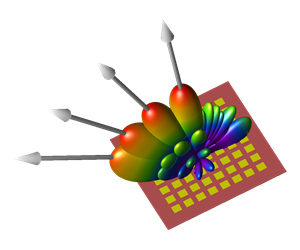MIMO And Array Design For 5G

Antenna engineers favor advanced antenna systems capable of beam steering and multiple data stream transmission in order to meet 5G throughput requirements. Designing such a device is a difficult task because many factors are involved a device’s performance:
- Antenna coupling within a device’s case
- Effects of multipath propagation
- Data transfer schemes
XFdtd and Wireless InSite ensure a comprehensive device design process, from simulating the initial antenna pattern to computing throughput performance in a multipath channel model. Together the products ensure a device will work well in its intended environment.
Standalone Device Performance

- Antenna isolation
- Envelope cross correlation
- Antenna efficiency
- Radiation patterns
An RF engineer needs to go beyond standalone antenna performance in order to ensure sufficient 5G device performance. Results from an XFdtd simulation that characterize the performance of an antenna are easily exported to Wireless InSite where the device is analyzed in its intended environment.
3D Channel Model

- City blocks for small cell base station deployment
- Outdoor-to-indoor for fixed wireless access scenarios
- Office buildings for WiFi access planning

- 3D terrain, buildings, and floor plans
- Fine structural details including curbs, window frames, chairs, and desks
- Diffuse scattering at millimeter waves
- Attenuation from trees, shrubs, and other foliage

- Complex impulse response at each receiver
- Received power
- Coverage maps
- Power delay profiles
- H-matrices connecting each antenna element on a base station or access point to those on a UE or device
Once the 3D propagation scenario has been characterized, communication systems can be overlayed to determine throughput and capacity metrics.
Communication System Metrics
Given the antenna design and 3D channel model, Wireless InSite’s Communication Systems Analyzer allows the RF engineer to evaluate a 5G device’s operation in the intended scenario.

- Antenna diversity
- Spatial multiplexing
- Beamforming
MIMO techniques determine how data is transmitted through the 3D environment. Once that is known, Wireless InSite determines how much data can be transmitted. The following metrics are accessed for each data stream and point-to-point link:
- Throughput and capacity
- Bit error rate (BER)
- Noise, interference, and SINR
This results in a powerful tool that engineers use to determine if their device will meet 5G performance requirements in a realistic operating environment.
